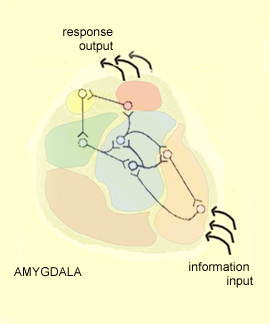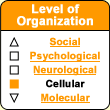|
|
When someone suffers a particularly
traumatic experience, it bombards their amygdala
with electrical and chemical signals that condition its circuits.
Thus, for example, the sounds, images, and smells of the battlefield
become associated in the circuits of a soldier's amygdala
with the traumatic emotional experience of having friends killed
in combat.
Even years later, some of these same stimuli, or others associated with them, may suffice to trigger an intense fear reaction, by reactivating these strongly conditioned circuits in the amygdala. |
|
|
| THE TRACES OF ANXIETY IN THE
CIRCUITS OF THE AMYGDALA |
|
Anxiety, like fear and
other emotions, reflects the activity of specific, identifiable circuits
in the brain. Early on, researchers studying the brain circuits involved
in anxiety realized that the amygdala was
a key structure for understanding this phenomenon. The amygdala is
a complex structure in the brain and is composed of several
interconnected nuclei.
The sensory stimuli associated
with pain follow one of two
pain pathways to the brain, then converge at the lateral
nucleus of the amygdala. Because of its position at the
"gateway" to the amygdala, this nucleus seems to
play an important role in the process of fear conditioning,
which underlies many anxiety disorders (follow the Experiment
module link to the left).
The nerve cells in the lateral nucleus of the amygdala project
their axons to its other nuclei, thus forming various circuits
that ultimately converge on the central nucleus. This nucleus
acts as the output pathway from the amygdala, which in turns
activates the hypothalamus, the locus
coeruleus, and other parts of the brain that are responsible
for the characteristic symptoms of anxiety.
|
|
 |
During the fear-conditioning process, certain internal circuits
in the amygdala may be strengthened to create a memory trace of
the conditioned fear. Such traces appear to be very persistent,
and perhaps even permanent. If these potentiated circuits in the
amygdala are strengthened enough, they could even become the source
of a specific
phobia.
Many researchers think that fear conditioning records memories
in these strengthened circuits of the amygdala permanently. Hence
these researchers believe that the efforts
involved in psychotherapy achieve their positive results not
by removing the fearful memories encoded in the amygdala's circuits,
but rather by strengthening other neural pathways, particularly
ones originating in the cortex, that calm these circuits.
This is why a phobia that seemed to have been successfully cured
through therapy can re-emerge suddenly during a particularly stressful
event. The calming influence of the cortex no longer suffices,
and the conditioned fear in the circuits of the amygdala expresses
itself once again.
Unconscious fears that result from early conditioning seem
to be etched in the amygdala's circuits permanently. The persistence
of these fears throughout our lives would represent an advantage
if we were living in a stable environment like our
ancestors did, because it would save us from having
to constantly relearn that a given situation was dangerous.
But in our complex modern world, where change is an integral
part of our daily lives and the contexts in which we operate
are no longer the same, persistent fears can become a handicap
instead. Thus we pay a heavy price for the formidable efficiency
of the
fear pathways in our nervous systems.

|
|
|





